Eugene Peyton Deatrick
Eugene Peyton Deatrick Jr. (born November 17, 1924) is a retired United States Air Force colonel, test pilot, and combat veteran. He is best recognized for his role in the rescue of United States Navy Lieutenant Dieter Dengler during the Vietnam War. The rescue was recounted in the Werner Herzog films Little Dieter Needs to Fly and Rescue Dawn and the national bestseller Hero Found: The Greatest POW Escape of the Vietnam War by author Bruce Henderson.
Eugene Peyton Deatrick Jr. | |
|---|---|
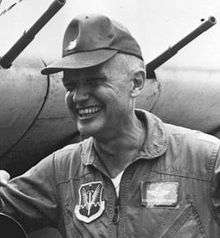 Gene Deatrick by A-1E Skyraider in 1966 | |
| Nickname(s) | Gene |
| Born | November 17, 1924 Pittsburgh, Pennsylvania, U.S. |
| Allegiance | |
| Service/ | |
| Years of service | 1943–1974 |
| Rank | |
| Commands held |
|
| Battles/wars | Vietnam War |
| Awards |
|
| Other work | Aerospace Representative |
Early life and education
Eugene P. Deatrick Jr. was born November 17, 1924, in Pittsburgh, Pennsylvania, the only child of Dr. Lily Bell Sefton Deatrick and Dr. Eugene P. Deatrick, Sr. He grew up in Morgantown, West Virginia where his mother was a professor of Chemistry[1] and his father a professor of Agriculture[2] at West Virginia University. Deatrick graduated from Woodrow Wilson High School in Washington, D.C. in 1942. During his first year of college at West Virginia University, Deatrick enlisted in the Air Corps Reserve. He was nominated to the United States Military Academy by Senator Jennings Randolph in 1943.[3]
Military career
United States Military Academy
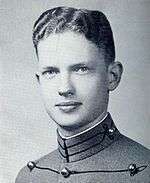
Deatrick arrived at West Point on July 1, 1943 and began six weeks of military training known as Beast Barracks due to the verbal abuse and hazing delivered by upper classmen to toughen the cadets.[4] Cadets were grouped according to height,[5] and the six-foot tall Deatrick was assigned to Company C, 1st Regiment known as "C1".[6] Deatrick's interest in aviation was piqued during his freshman or "plebe" year when an AT-6 aircraft simulated a strafing attack on his group that was on field maneuvers sending them into the bushes to escape. As he watched the pilot wave, Deatrick decided he would apply for flight training when the opportunity arrived.[7] A wartime change allowed cadets in their second year (known as "yearlings") to apply to become air cadets who upon graduation would receive both a commission and wings.[8] Deatrick was accepted into the program and received basic flight training in 1945.[9] On June 1, 1946, the air cadets received their wings from the commanding general of the Army Air Forces, Carl Spaatz.[10] Deatrick graduated from USMA on June 4, 1946 with a merit ranking of 252 out of the 875 members of his class.[11]
Air rescue
Deatrick entered the U.S. Army Air Corps following graduation from the United States Military Academy. Deatrick flew B-25s at Enid, Oklahoma then transitioned to the 307th Bomb Wing at MacDill AFB in Florida where he flew B-29s. From 1947 to 1948, he served a tour with the 10th Air Rescue Squadron in Adak, Alaska where he flew B-17s, L-5s, and PBYs.[12] The noted Norwegian Arctic explorer, Colonel Bernt Balchen, was his commanding officer.[3]
Flight test
In 1949, he was assigned to the 3759th Electronics Test Squadron whose mission was the development of new radar bombing equipment. In 1950 the squadron moved to Eglin Air Force Base, Florida as the nucleus of the new Air Armament Center. Deatrick was assigned as the Bomber Engineering Test Pilot. In addition to bombers, he flew the T-33, P-51,[12] and the F-84.[13] In 1951, Deatrick was a member of the first class[14] to attend the newly formed Experimental Test Pilot School[15] at Edwards Air Force Base, California, and subsequently served five years in the Bomber Flight Test Division at Wright Patterson AFB, Ohio. During this tour of duty, he flew development tests on the B-47 and B-52 aircraft among many other programs.[12]

Deatrick also participated in nuclear weapons effect tests in these aircraft at the Pacific Proving Grounds in 1954 and 1956. During Operation Castle, he flew a B-47 to test thermal and overpressure effects of an atomic blast on aircraft in flight. A year later, in preparation for Operation Redwing, Deatrick received B-52 instruction at Boeing Field near Seattle, Washington. In August 1955, Col. Guy Townsend "signed off" Deatrick and qualified him to fly the Boeing bomber.[16] B-52B serial number 52-0004, the first B model aircraft, was extensively instrumented to measure thermal, blast, and gust effects of a nuclear explosion.[17] The aircraft was redesignated a JB-52B and nicknamed by the crew, The Tender Trap, after the movie of the same name. In March 1956, pilot Charles G. "Andy" Anderson and co-pilot Deatrick left Seattle for Eniwetok.[16] They participated in eight "shots" including, Cherokee, the first airdrop of a thermonuclear bomb, and Zuni, the first test of a three-stage thermonuclear design.[17][18]
From 1956 to 1964, Deatrick was assigned as executive officer to Major General Howell Estes Jr. He followed Estes on many assignments throughout the world. In 1965, he volunteered for Vietnam. Deatrick received indoctrination in the A-1 Skyraider at Hurlburt Field, Florida, and graduated with class Express-20.[3]
Vietnam
In March 1966, Deatrick assumed command of the 1st Air Commando Squadron (ACS) located at Pleiku, RVN.[19][20][21] On his fourth flight (an orientation mission), Deatrick was diverted into the A Shau Valley to help defend a Special Forces camp that was under attack. The next day, March 10, 1966, Bernie Fisher of the 1st ACS landed on the enemy-held runway and successfully rescued "Jump" Myers who had been shot down earlier that day. Fisher was later awarded the Medal of Honor for this rescue. While in Vietnam, Deatrick flew 402 combat missions in the A-1E Skyraider.[12] He was responsible for the rescue of Lt. Dieter Dengler, United States Navy, who had escaped from a prison camp after six months of captivity.[22][23] Dengler later wrote about the miraculous circumstances of his July 20, 1966 rescue:
Because the wings of a Spad are set into the fuselage right under the canopy, a pilot can see the ground directly beneath him only when he banks ninety degrees. When Gene was perhaps three seconds into this steep bank, and only during those few seconds, he saw a flash of something white on the ground, a thousand feet below. I was lying on a flat boulder and waving a parachute, but all Gene saw was that brief flash of white ... He went back for another look ... Now he saw the waving and this time the form of a man.[24]

On November 10, 1966, Deatrick came to the aid of West Point classmate, Eleazar Parmly IV, commander of Task Force (TF) Prong when it was ambushed by NVA forces.[25][26] TF Prong, consisting of three Montagnard companies supported by U.S. Special Forces advisors, was acting as a screen for elements of the U.S. 14th Infantry. TF Prong was scouting in the Plei Trap Valley near the Cambodian border when it was attacked by the NVA Sixth Battalion.[25][27] With the battle turning against him, Parmly radioed Captain Partridge, a Forward Air Controller working the area:
Do you know Colonel Eugene Deatrick, CO of the 1st Air Commando Squadron at Pleiku?"
"Sure do," Partridge replied.
"Good," said Parmly. "Then give him word that his old classmate is in deep shit down here."
Maybe that could be called working the old school tie till the knot got frayed. Even so, Parmly got Deatrick's forget-you-not within less than 10 minutes. … Parmly used the bombardment as cover to move his people to the east of the trail.[25]
To strengthen ties with the soldiers they protected, Deatrick encouraged his flyers to take troops on orientation flights above the battle fields.[28] His pilots also worked on the ground directly with the soldiers to improve communications and select munitions best-suited for close air support missions.[28]
USAF Test Pilot School
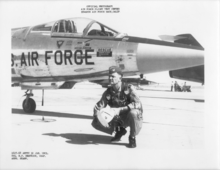
Deatrick returned to the United States in early 1967 and was assigned as commandant of the USAF Aerospace Research Pilot School, Edwards Air Force Base, California, from May 1967 to June 1968.[29] During a ceremony with Colonel Deatrick on July 11, 1967, the school received its first Air Force Outstanding Unit Award for "exceptionally meritorious service" during the period of February 1, 1964 to February 1, 1966.[30]
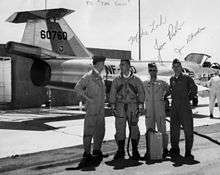
During Deatrick's tenure at the school, students received the long-awaited Lockheed NF-104A—a rocket-powered variant of the F-104 intended to inexpensively train military space pilots.[31] More than five years before, three F-104s were extensively modified to the NF-104A or Aerospace Trainer (AST) configuration that included the addition of a rocket engine and a reaction control system for flight in the upper atmosphere where the air is too thin for normal control surfaces to operate.[32] Although the school managed the project, testing was performed not by the school's students, but by experienced test pilots from Lockheed and the Air Force Flight Test Center.[33] Flight testing began in 1963 but was suspended when aircraft 56-0762 was destroyed on 10 December, seriously injuring the pilot.[34] Safety modifications were made to the two remaining aircraft, and a restricted flight profile was defined that lowered the maximum altitude and decreased the climb angle.[35] In spite of the precautions, a serious accident occurred on June 18, 1965 when an instructor flying 56-0756 experienced a hydrogen peroxide fire from the reaction control system.[36] A nitrogen purge system was added, and after additional test flights, the school's students were finally approved for training flights in May 1968.[31]
Students who flew the NF-104A while Deatrick commanded the school include Robert Lilac, Harry Blot, and Mike Loh.[37] Student flights lasted only a few more years. Aircraft 56-0756 was scrapped after an inflight rocket motor explosion occurred in June 1971 and training was terminated in December of that year.[38] As of 2011, the surviving NF-104, 56-0760, stands as a static model just outside the entrance of the USAF Test Pilot School.
On May 27, 1967, Deatrick presented an address at Kutztown State College in Pennsylvania during the unveiling of the datestone of Deatrick Hall. The men's dormitory was named in honor of Deatrick's grandfather, William Wilberforce Deatrick, who was a professor at the college.[39] In 1968, Deatrick was selected to attend the National War College. Following his graduation in 1969, he was assigned to the Joint Staff, Office of the Joint Chiefs of Staff. Subsequently, in 1972, he became the Director of Test, Air Force Systems Command, Andrews AFB, Maryland and retired from the United States Air Force in 1974.[12]
Later years
_and_Colonel_Charles_Webb_Test_Pilot_School_Commandant_USAF_October_22._2014._141020-F-IW159-006.jpg)
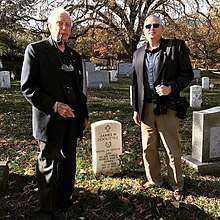
In 1996, Deatrick portrayed himself in Little Dieter Needs to Fly, the Werner Herzog documentary about the escape and rescue of Dieter Dengler.[40] In 1997, Deatrick was interviewed by the Air Force Historian, Richard P. Hallion, during the review of Operation TAILWIND.[41] On March 9, 1999, on the thirty-third anniversary of the Battle of A Shau, Deatrick and other members of the 1st ACS gathered at a Pentagon ceremony to honor Bernie Fisher.[42] In 2007, he attended the premier of Rescue Dawn at Andrews AFB[43] and spoke of his role in Dengler's rescue.[44] As of 2012, he lives in Alexandria, Virginia. Deatrick's wife of 55 years, Zane, died in January 2012 and is buried in Arlington National Cemetery.[45]
In October 2014, Deatrick returned to Edwards AFB to attend the 70th anniversary celebration of the United States Air Force Test Pilot School presented during the Flight Test Historical Foundation's Gathering of Eagles event. Before touring the school to view the many improvements since his tour as commandant in 1967, Deatrick attended a mission briefing presented by current TPS commandant, Colonel Charles Webb Jr. Deatrick was especially pleased to find that TPS students now receive a Master of Science degree in flight test engineering upon graduation.[46]
Awards and honors
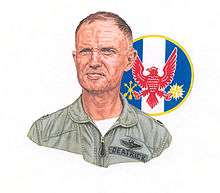
During his career, Deatrick flew more than 50 different types of aircraft and accumulated more than 12,000 hours of flying.[12] He was awarded the Legion of Merit with one oak leaf cluster, the Distinguished Flying Cross with one oak leaf cluster, the Bronze Star with Valor device and one oak leaf cluster, and the Air Medal with 22 oak leaf clusters.[12] In 1969, he earned a master's degree from George Washington University.
Deatrick was one of the twelve founding members of the East Coast chapter of the Society of Experimental Test Pilots (SETP) in 1959,[47] and he served as symposium chairman for the sixth annual SETP conference in 1962.[48] Deatrick was made an Honorary Member of the Fighter Aces Association in 1968. He served as President of the National Aviation Club for three years and is a member of the International Order of Characters, the Order of Daedalians,[49] the Air Force Association, and the Quiet Birdmen. In 1995, Deatrick and Dengler presented a lecture at the Estrella Warbird Museum describing Dengler's imprisonment and rescue.[50] The lecture was well received and eventually recorded as part of the National Museum of the United States Air Force's Guest Lecture Series.[51] In January 1999, he received the National Aeronautic Association's Cliff Henderson Award for Aviation Achievement.[52]
In 2000, Deatrick was awarded membership in the Gathering of Eagles Program[12] along with other noted aviators including Duke Cunningham, Fitz Fulton, Michael Novosel, Günther Rall, Ed Rector, and Chuck Yeager.[53] In 2001, Deatrick was selected as the Distinguished Alumnus of the U.S. Air Force Test Pilot School and spoke at the graduation dinner banquet.[3] In 2005, he received the National Aeronautic Association's Wesley L. McDonald Elder Statesman of Aviation award for his service to the United States military, especially as one of its top test pilots.[54][55] In 2006, Deatrick was an invited panelist for the 38th National Conference on Aviation and Space Education's Hangar Talk tribute to the late Scott Crossfield.[56][57] In 2007, he was recognized as a "famous flyer" of the A-1 Skyraider.[58] At the 51st Symposium in Anaheim, California, Deatrick was interviewed as part of SETP's History Series documenting the flight test careers of noted test pilots.[3] In 2018, SETP released a video of Deatrick's oral history interview.[59] In 2019, the West Point Center for Oral History interviewed Deatrick and released a video of his career.[60]
 | ||
| Insignia | Command pilot | |||||||||||
|---|---|---|---|---|---|---|---|---|---|---|---|---|
| Row 1 | Legion of Merit w/ 1 oak leaf cluster | Distinguished Flying Cross w/ 1 oak leaf cluster | Bronze Star Medal w/ valor device and 1 oak leaf cluster | |||||||||
| Row 2 | Air Medal w/ 22 oak leaf clusters | Air Force Commendation Medal w/ 1 oak leaf cluster | American Campaign Medal | |||||||||
| Row 3 | World War II Victory Medal | National Defense Service Medal w/ service star | Antarctica Service Medal | |||||||||
| Row 4 | Vietnam Service Medal | Republic of Vietnam Gallantry Cross with Palm | Republic of Vietnam Campaign Medal | |||||||||
See also
Notes
- "Recent Deaths" (PDF). Science. American Association for the Advancement of Science. 105 (2724): 277–281 [281]. March 14, 1947. doi:10.1126/science.105.2724.277. Archived from the original (PDF) on October 29, 2008. Retrieved December 31, 2016.
- "University and Educational News". Science. American Association for the Advancement of Science. LIV (1394): 247–8 [248]. September 16, 1921. doi:10.1126/science.54.1394.247. Retrieved April 23, 2017.
- Kilanowski 2007.
- McWhorter 1993, p. II-2.
- McWhorter 1993, p. II-7.
- McWhorter 1996, p. D-7.
- Kilanowski 2007, Event occurs at 2:17.
- McWhorter 1993, p. II-15.
- USMA 1946, p. 49.
- McWhorter 1993, p. II-19.
- USMA 1946, p. 33.
- "Deatrick Eagle Biography". Gathering of Eagles Foundation. 2000. Retrieved May 27, 2019.
- Hutchison 2009, p. 112.
- (1994) USAF Test Pilot School 50 Years and Beyond, p. 70
- "U.S. Air Force Test Pilot School History, The Move West". Edwards Air Force Base. United States Air Force. March 22, 2013. Archived from the original on January 26, 2016. Retrieved January 20, 2017.
- Dorr, Peacock & Holmes (2000), pp. 34–38.
- Williams (1959), p. 5.
- Williams (1959), p. 35.
- Keeler, VIP Pilot, p. 170.
- Digital Journalist Larry Burrows' Photo of 1st ACS CO E. Deatrick's 100th Combat Mission, retrieved January 15, 2008
- Mutza (2003), p. 53.
- Skyraider Association, Escape from Laos Excerpts, retrieved January 15, 2008
- LaPointe, PJs in Vietnam, p. 229
- Dengler, Escape from Laos, pages 207-208
- Marshall, West to Cambodia, p. 88
- Simpson, Inside the Green Berets, p. 203
- Gruenther, The Crusade of a Green Beret, p. 50
- Campbell, D (2003). The Warthog and the Close Air Support Debate. p. 52. ISBN 978-1-55750-232-2.
- (1994) USAF Test Pilot School 50 Years and Beyond, p. 63
- (1989) USAF Test Pilot School 45 Anniversary, p. 79
- Libis (1999), p. 35.
- Marrett (2008), pp. 60–61.
- Libis (1999), p. 2.
- Marrett (2002).
- Marrett (2008), p. 101.
- Marrett (2008), pp. 101–2.
- Wright, Michael (August 5, 2007). "NF-104 Space Pilot Trainer". Retrieved May 16, 2011.
- Libis (1999), pp. 35–7.
- Meiser, IX (1983).
- Anderson, Jeffrey M. (May 23, 2002). "The 'Fly' Papers". Combustible Celluloid. Retrieved April 21, 2017.
- "Operation TAILWIND Review, Extract of U.S. Air Force Report". United States Air Force. July 16, 1998. Archived from the original on June 9, 2011. Retrieved April 21, 2017.
- Correll (2004), p. 54.
- Miles, Donna (June 19, 2007). "'Rescue Dawn' Premiere Inspires, Provides Example for Today's Troops". DefenseLink. Washington, D.C. Archived from the original on May 19, 2008. Retrieved April 21, 2017.
- Lopez, C. Todd (June 21, 2007). "AF Aviator Recounts Participation in Rescue Operation". Capital Flyer. Andrews Air Force Base, Maryland. Archived from the original on October 8, 2007. Retrieved April 21, 2017.
- "Zane L. Deatrick Death Notice". The Washington Post. February 5, 2012. Retrieved June 24, 2012.
- Amber 2014.
- Engen, Wings and Warriors, p. 216
- "Test Pilots' Symposium". Flight International. Reed Business Information Ltd: 79. July 19, 1962. Archived from the original on February 27, 2017. Retrieved January 19, 2020.
- "Flightline" (PDF). Daedalus Flyer. San Antonio, Texas: Daedalian Foundation. LIX (4): 45. December 2018. Retrieved December 2, 2018.
- Marrett, G. Cheating Death. p. 220. ISBN 978-1-58834-104-4.
- "Escape from Laos Video Lecture" (PDF). Of Wings and Things Guest Lecture Series. United States Air Force. p. 13. Archived from the original (PDF) on October 30, 2017. Retrieved May 27, 2019.
- "Henderson Trophy Recipient Chronology". Arlington, Virginia: National Aeronautic Association. 1999. Retrieved January 4, 2015.
- "Gathering of Eagles 2000 Index". Gathering of Eagles Foundation. 2000. Retrieved May 27, 2019.
- "Wesley L. McDonald Elder Statesman Award" (PDF). NAA News. Washington, D.C.: National Aeronautic Association. September 9, 2005. Retrieved January 19, 2020.
- "Wesley L. McDonald Elder Statesman Award". NAA Awards. Washington, D.C.: National Aeronautic Association. 2005. Archived from the original on February 4, 2012. Retrieved January 19, 2020.
- "NCASE Program Guide" (PDF). Civil Air Patrol. 2006. pp. 11–12. Retrieved April 22, 2017.
- "NCASE 2006 Remembers Scott Crossfield" (PDF). Civil Air Patrol. 2006. p. 1. Archived from the original (PDF) on September 23, 2006. Retrieved April 22, 2017.
- Boyne 2007, p. 88.
- "Eugene Deatrick Oral History Video". Lancaster, California: The Society of Experimental Test Pilots Foundation. October 2018. Retrieved November 3, 2018.
- Siry, David (July 16, 2019). "One Helluva Career: Testing Planes And Rescuing A POW In The Air Force". West Point, New York: The West Point Center for Oral History. Retrieved October 25, 2019.
References
- Amber, Rebecca (October 22, 2014). "Gathering of Eagles honors 70 years of TPS". Inside Edwards. Edwards Air Force Base, California: United States Air Force. Archived from the original on October 18, 2016. Retrieved April 17, 2017.CS1 maint: ref=harv (link)
- Boyne, Walter J. (June 2007). "Airpower Classics, A-1 Skyraider" (PDF). Air Force Magazine. Archived from the original (PDF) on March 27, 2009. Retrieved January 4, 2015.CS1 maint: ref=harv (link)
- Campbell, Douglas (2003). The Warthog and the Close Air Support Debate. Naval Institute Press. ISBN 978-1-55750-232-2.
- Correll, John T. (October 2004). "Into the Valley of Fire" (PDF). Air Force Magazine. Archived from the original (PDF) on July 23, 2012. Retrieved January 4, 2015.CS1 maint: ref=harv (link)
- Dengler, Dieter (1979). Escape from Laos. Presidio Press. ISBN 978-0-89141-076-8.
- Dorr, Robert F.; Peacock, Lindsay T.; Holmes, Tony (2000). B-52 Stratofortress: Boeing's Cold War Warrior. Osprey Publishing, Limited. ISBN 978-1-84176-097-1.CS1 maint: ref=harv (link)
- Engen, Donald D. (1997). Wings and Warriors. Smithsonian Institution Press. ISBN 978-1-56098-795-6.
- Gruenther, Richard L.; Parmly, David W. (March 1992). "The Crusade of a Green Beret". Special Warfare. Fort Bragg, North Carolina: John F. Kennedy Special Warfare Center and School. 5 (1): 42–55. Retrieved January 4, 2015.
- Hutchison, Sheryl (2009). Mentor Inbound: The Authorized Biography of Fred J. Ascani, Major General, USAF Retired: Holder of the 1951 World Speed Record. Authorhouse. ISBN 978-1-4389-9973-9.CS1 maint: ref=harv (link)
- Keeler, Albert T. (2001). VIP Pilot. Privately Published.
- Kilanowski, Dana (Historian) (2007). SETP History Series, Interview with Eugene Deatrick (DVD). Society of Experimental Test Pilots.
- LaPointe, Robert L. (2001). PJs in Vietnam. Northern PJ Press. ISBN 978-0-9708671-0-0.
- Libis, Scott (1999). Lockheed NF-104A Aerospace Trainer (Air Force Legends Number 204). Steve Ginter. ISBN 978-0-942612-97-4.CS1 maint: ref=harv (link)
- Marrett, George J. (2003). Cheating Death: Combat Air Rescues in Vietnam and Laos. Smithsonian Books. ISBN 978-1-58834-104-4.CS1 maint: ref=harv (link)
- Marrett, George J. (2008). Contrails Over the Mojave: The Golden Age of Jet Flight Testing at Edwards Air Force Base. Naval Institute Press. ISBN 978-1-59114-511-0.CS1 maint: ref=harv (link)
- Marrett, George J. (November 1, 2002). "Sky High: My Climb to the Top in the F-104". Air & Space Magazine. Retrieved July 31, 2016.CS1 maint: ref=harv (link)
- Marshall, S. L. A. (1968). West to Cambodia. Cowles Education Corp. ISBN 978-0-89839-078-0. LCCN 68031132.CS1 maint: ref=harv (link)
- "Official register of the officers and cadets for the academic year ending 30 June 1946". West Point, New York: United States Military Academy. 1946. Retrieved February 25, 2017.
- McWhorter, John C. Jr (1993). United States Military Academy, Class of 1946, A Chronicle of Duty - Honor - Country. Kerrville, Texas: Herring Printing Company. LCCN 93-91386.CS1 maint: ref=harv (link)
- McWhorter, John C. Jr (1996). West Point Revisited, Reminiscences of the Class of 1946 50 Years Later. Kerrville, Texas: Herring Printing Company. ASIN B00FM0LPXY.CS1 maint: ref=harv (link)
- Meiser, IX, George M. (April 6, 1983). "W. W. Deatrick left his mark at Kutztown". Reading Eagle. Reading, Pennsylvania: Reading Eagle Press. Retrieved June 7, 2009.CS1 maint: ref=harv (link)
- Mutza, Wayne (2003). The A-1 Skyraider in Vietnam: The Spad's Last War. Schiffer Publishing Ltd. ISBN 978-0-7643-1791-0.CS1 maint: ref=harv (link)
- Simpson, Charles M. (1983). Inside the Green Berets. Presidio Press. ISBN 978-0-89141-163-5.
- USAF Test Pilot School 45th Anniversary. Privately Published. 1989.
- USAF Test Pilot School 50 Years and Beyond. Privately Published. 1994.
- Williams, Capt. F. L. (October 23, 1959). "Operation Redwing, Project 5.2 In-Flight Participation of a B-52". Albuquerque, New Mexico: Defense Atomic Support Agency. Archived from the original (PDF) on February 3, 2015. Retrieved December 31, 2016.CS1 maint: ref=harv (link)
External links
| Wikimedia Commons has media related to Eugene Peyton Deatrick. |
- "Eugene Deatrick Filmography". Internet Movie Data Base. 2008. Retrieved April 21, 2017.
- "Express-20 A-1 Skyraider Class Photo". Skyraider Association. March 9, 1999. Retrieved April 21, 2017.
- "Pentagon Ceremony for MOH Recipient Bernie Fisher". Skyraider Association. March 9, 1999. Retrieved April 21, 2011.
- Styling, Mark (2004). "Illustration of JB-52B, 52-004—The Tender Trap". AviationIllustration.com. Retrieved September 2, 2018.